Benedict Arnold's Portraits
By Stephen DarleyThe purpose of this article is to look at the known portraits of Major General Benedict Arnold, which have appeared in various countries and various publications beginning in 1776. We will examine each to determine which ones, if any, are true and accurate portrayals and which ones, if any, are to be discounted and eliminated because they are not authentic. With all that has been written about Benedict Arnold, no one has taken a comprehensive look at his portraits to see what he really looked like. Benedict Arnold was a major figure in the American Revolution as is evidenced by the continuous interest in his life, military career and subsequent treason. Over the years more has been written about Arnold than any other Revolutionary War figure with the exception of George Washington. Arnold is interesting not only because he was one of the most successful Revolutionary generals but more important because he seemed to engage in the ultimate act of betrayal. His history is really the history of the Northern army in the first three years of the Revolution. It is no wonder that so much has been written and that his story has intrigued so many historians.
Hart Engraving
The earliest Benedict Arnold portrait is a mezzotint engraving of a three-quarter length portrait of Arnold with his right hand outstretched and Quebec in the background. Thomas Hart issued this portrait in London on March 26, 1776. The portrait is entitled "Col Arnold who Commanded the Provincial Troops Sent to Quebec Through the Wilderness of Canada and was Wounded in Storming that City Under General Montgomery". This engraving was frequently copied in England and America and was reissued in both France and Germany. A copy of this mezzotint is in the Emmett Collection, New York Public Library; Webster Collection, New Brunswick Museum, Canada; and the Anne S.K. Brown Collection, Brown University, Providence, RI. The original plate is now in the British Museum.[1]
The French version of this engraving was issued in 1777 with the title "General Arnold. Qui Avec le General Gates Aidat de Environer le General Lieutenant Bourgoyne, Qui Toute l'Armee se rendut Provoniere, et l'obligea de Mettre bas les Armes". This plate is in the Bibliotheque Nationale, Paris.[2]

The Hart engraving of Benedict Arnold
A German version of the Hart engraving was published in a rare German book by Christopher Heinrich Korn entitled "Geschichte der Kriege in und ausser Europa, Eilfter Theil" which was published in Nuremberg in 1777-1778.[3] The print is entitled "Der Americanische Gener: Arnold" or The American General Arnold and is 6" X 3". A current offering of this print is described as "A fictitious portrait of General Benedict Arnold based on a standing image that was credited to C. Corbutt [R. Purcell]' in London in 1776. The unknown German engraver used the same body pose and head tilt to convey a half bodied portrait."[4] A copy of this print is in the Fort Ticonderoga Museum.
The Hart engraving of Arnold is one of a series of six engravings of famous Americans who were in the Revolutionary War, including Hopkins, Sullivan, Wooster and Robert Rogers of Roger's Rangers fame. All six were issued in London in 1776 by Hart to take advantage of the strong interest in England regarding the American participants.
Charles Henry Hart has concluded that all of the Hart portraits are fictitious in an article published in the Annual Report of the American Historical Association for the Year 1913.[5] The author analyzes the six Hart portraits and determines that they have many similarities even though they purport to be different people. He says the faces are similar with each possessing protruding lips, protruding eyes and prominent noses. In addition, he finds that each has narrow shoulders with a small but definite paunch. Despite superficial differences, they all have similar postures and uniforms. As a subsequent commentator has observed "Thomas Hart was interested in making some money from the current interest in the American rebellion; the veracity of the portraits mattered little".[6]
Based on the expose of the Hart portraits contained in the 1913 article, it is clear that James Thomas Flexner was correct when he referred to this portrait of Arnold as "imaginary"[7]. It should not and cannot be used to represent a fair and accurate portrayal of Arnold's features and likeness. Asthe title of the 1913 article indicates, this portrait is a fraud.
One of the many 20th century books to feature the Hart portrait is March to Quebec by Kenneth Roberts where the Hart print is used as the frontispiece. Mr. Roberts prided himself on historical accuracy so it is very surprising that he allowed this portrait to be used in his book about the expedition to Quebec led by Arnold. Another recent book to utilize this portrait, actually on the front of the dust jacket, is Willard Sterne Randall's Benedict Arnold: Patriot and Traitor. The portrait is also used on the jacket of a recent novel about Arnold by John Ensor Harr. Finally, the Hart portrait is also shown in the most recent Arnold biography written by James Kirby Martin, although not as prominently as the others mentioned above. From these examples it is clear that even though the Hart portraits were shown to be frauds in 1913 they are still being used today to portray Arnold.[8]
Du Simitiere Portrait
Pierre-Eugene Du Simitiere was born in Switzerland and settled in Philadelphia in 1766. As Mark Boatner says in his Encyclopedia of the American Revolution, "The Swiss was an avid collector of natural curiosities, books and pamphlets. In 1782 he opened his celebrated collection to the public as the 'American Museum'. Sold in 1785, his papers and printed materials are preserved in the Library Company of Philadelphia and the Library of Congress." [9]
By the end of 1779, he had drawn portraits of some of the most famous Americans of the day, including Washington, Steuben, Deane, Gates and Arnold. Arnold certainly was in Philadelphia in 1779 when he was military governor of the city. It would be likely that Arnold would have known of Du Simitiere and would have wanted to have his picture drawn by such a well-known artist. The Du Simitiere portraits of the famous men of the Revolution "did much to establish the iconography of the 'famous men' therein represented" according to the editor of Chastellux's Travels in America.[10] From their first publishing, the Du Smitiere engravings were said to be made from life and have been accepted by most scholars and experts as being accurate portrayals of their subjects.
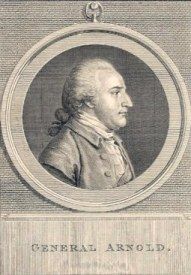
The Du Simitiere Portrait of Benedict Arnold
Van Doren in his Secret History of the American Revolution says that it "is the only likeness of Arnold known to have been made from life and probably the most lifelike".[11] On the other hand, a 19th century authority on Revolutionary War portraits says "The Du Simitiere engravings appear to have been in demand in England, although by common consent of the collectors of today they are adjudged poor portraits, even if they were 'taken from life'".[12]
Du Simitiere himself described his portraits in his commonplace book, as "...fourteen drawings in black lead, being portraits in profil in the form of a medaillon of eminent Persons engaged in the american war...".[13] The portraits were sent to Paris through the French Ambassador and were engraved there first by Benoit Louis Prevost in 1781. Prevost issued his portraits in two parts with the second part containing the Arnold portrait. Arnold's portrait is in profile looking right. The portraits were issued under the title of "Collection des Portraits des Generaux, Ministres & Magistrats" in the form of "circular framed medallions, hung against a rectangular plaque. The whole is enclosed by a double line. Size to plate line, 7 º by 5 1/8"; diameter of portrait, 2"."[14]
Very soon after the French engravings were issued they were copied by British engravers. The first British engraving was by Burnett Reading and was published by Richardson on May 10, 1783. Another soon after was issued on May 15, was published by Wilkinson and was signed "B.B.E.". Both of these were in reverse of the French originals. In addition, a set of 13 portraits by Du Simitiere was published in The European Magazine[15] on March 1, 1783 which were engraved by Fielding, again in reverse of the Prevost original.
There have been many subsequent reissues and copies of the original, some facing left and some facing right. H.B. Hall did the best known of the 19th century engravings for Irving's Washington and Smith's Andreana, both of which are facing right. Hall also did an engraving for Arnold's Arnold and Allyn's Battle of Groton Heights facing left.[16] The original engravings from the late 18th century were all of Arnold in civilian clothes. The Hall engravings show Arnold in a military uniform.
Due to its general acceptance as a genuine Arnold likeness, the Du Simitiere portrait appears in virtually all Arnold biographies beginning with Isaac Arnold, whose well-respected biography was written in 1880.[17] It is interesting to note, however, that two of the most recent biographies of Arnold do not feature the Du Simitiere portrait.[18]
There is no indication from the available records that the Du Simitiere portraits are anything other than as represented by the artist himself and his original engraver as "taken from life" This portrait, then, is the most authentic portrait of Arnold known to exist and until proven fraudulent must be accepted as an accurate portrayal.
Trumbull Portrait
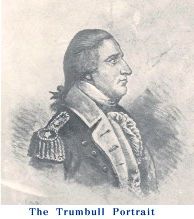
Trumbull Portrait of Benedict Arnold
The Trumbull painting of a portrait of Benedict Arnold was one of over 400 items which were first made known to the public in March of 1896 as part of the Frossard Collection which was being sold at auction by the American Art Galleries in New York. Items no. 171 through 415 of Part II "comprise my entire Collection of Trumbull Revolutionary and later Portraits, Groups, Sketches, and Studies, in oil, sepia, black and white, or pen, on canvas, india vellum and paper, drumheads, deerskin, book-covers, fly-leaves of books — either Trumbull's personal property, collected by him, or given to him by Washington and other men and women of the period."[19]
In describing his collection, Mr. Frossard stated: "With two exceptions, every Portrait and Sketch in Part II is the work of John Trumbull, period 1775-1819. Each bears a date, and his autographic signature, either in full or abbreviated; many also have on the back of the frames his autographic endorsement giving name of the subject, sometimes coupled with information of an interesting character, or with pasted clippings of old newspapers containing anecdotes, biographies, etc."[20]
Even at the time of the auction, there was some suspicion regarding these portraits and sketches. In 1941, John Hill Morgan[21] analyzed some of the available items from the Frossard sale and concluded that none of the portraits that he examined were actually Trumbull's work.
"To label as spurious the entire collection is unwarranted, as no one can have a fully justified opinion without examination of each separate item."[22] He then goes on to give what he feels is the best advice under the circumstances. "Whenever a small drawing appears representing an actor in the American Revolution, attributed to Trumbull (especially if it is signed J. T., with or without a plausible inscription and dated before 1780), it should be regarded with suspicion"[23]
Morgan finds four factors that question the authenticity of the Frossard drawings. First, is the date. He finds no contemporary evidence to show that Trumbull began painting prior to the mid 1780's. Trumbull's own autobiography says that his first painting was done in 1785. Second, is the presence of initials on the portrait. Morgan finds that the only Trumbull paintings that are initialed are the Frossard collection drawings. Why are not other Trumbull drawings initialed, as are those in the Frossard collection? Third, are the subjects of the drawings? Morgan questions why all of the questionable Frossard drawings are of Revolutionary War figures? Although not all of the Fossard drawings in the 1896 sale are of American Revolutionary subjects, all of the questionable items examined by Morgan were paintings of Revolutionary men. Fourth, is the size of the drawing. Morgan finds that all of the Frossard Revolutionary War subjects, including Arnold, are small drawings. The Fossard works are the only Trumbull drawings that are on small canvasses. He argues that with all of the other questionable factors this one makes the case against the Frossard drawings even stronger.
Morgan also indicates that the Frossard collection drawings do not have the same style and method as other drawings that are clearly the work of Trumbull. In sum, Morgan can find no compelling evidence to support the conclusion that the artist of the Frossard collection is John Trumbull.
The Frossard portrait of Benedict Arnold that is found in the book by William Abbatt on the Arnold-Andre affair[24] appears to comply with all of the Morgan criteria for questionable authenticity. Its subject is a major Revolutionary War figure, it is initialed with J.T., it is a small drawing and it is dated before 1780. The Frossard collection Arnold portrait shows a side view of Arnold facing right. He is wearing a Revolutionary Waruniform and has long hair tied in a queue.
A Trumbull painting also appears in the recent biography of Arnold by James Kirby Martin. That drawing is labeled as "An etching of Benedict Arnold drawn in the 1890s, from an original portrait by John Trumbull. Courtesy, Library of Congress"[25] That drawing, while having some differences, is clearly based on the Frossard collection drawing of Arnold. The Martin book portrait is also a side view facing right, wearing a uniform and has long hair in a queue. Morgan's work has called into question the authenticity of this so-called Trumbull drawing, even though it is from the Library of Congress.
After studying all of the Arnold portraits for this article, I am convinced that whoever actually drew the Frossard Arnold was copying from the Du Simitiere portrait to produce the final result. The similarities are very much there. Even though the uniform is different and the hair is different, it is the same basic portrait. What is being put forward by some as a Trumbull portrait is actually a very clever copy of the Du Simitiere portrait "from life".
Arnold Miniature
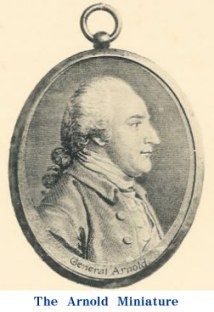
Miniature engraving of Benedict Arnold
A miniature of Benedict Arnold appears in the 1931 book by J.G. Taylor which identified the actual burial place of Arnold and his wife.[26]. The miniature appears in the frontispiece of the book and is described as being "From a miniature engraving worn by his wife" The miniature is in the form of a medallion and has the words " General Arnold" along the bottom. The portrait shows a side view of Arnold facing right dressed in civilian clothes and not a uniform.
Since there is no explanation in the book as to where the author got his copy of the miniature or who painted it and when, one is left to try to determine what this is and whether it is authentic. If it really was worn by Peggy Arnold it would have a high probability of being a fair and accurate portrait of Arnold. Why would his wife wear a miniature that is not a true likeness? It is only speculation to say that it must have been shown to the author by a family descendant. It is frustrating that the author did not clarify this situation for his readers.
My own conclusion after examining this and the other Arnold portraits is that this is also one of the copies of the Du Simitiere portrait. The likeness to the original Du Simitiere is striking and obvious. Perhaps it was also clear to the author that it was a Du Simitiere copy and, therefore, needed no explanation. We will never know for sure.
Murray Portrait
I have designated the heading for this Arnold portrait as the Murray portrait, not because it was painted by Murray, but rather because it first appears in the history of the Revolutionary War written by James Murray[27]. The Murray history was published in London in 1780 and in Boston in 1781-82. The Boston edition is rarer and more desirable because of the quality of its prints, which are considered excellent examples of 18th century American prints. The Arnold print in the Murray book shows a frontal view of a uniformed figure with a white powdered wig who could be any British army officer.
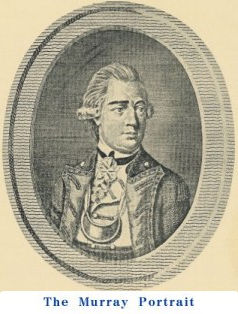
Murray portrait of Benedict Arnold
As William Loring Andrews points out in his book, Portraiture of the American Revolutionary War[28], the English edition and the American edition of the Murray book each contain 12 portraits but "the same individuals are not portrayed in each". For example Arnold is in the English edition but not the American edition. No information is provided as to the identity of the artist or artists who produced the Murray portraits in either the English or American edition.
Andrews quotes the following review of Murray's Impartial History from " The Freeman's Journal" of 1795: "A new American history of the late war, says a literary correspondent, seems to be much wanting; one in which impartiality, strict truth, elegance and precision shall be united...The expense of copper plates, however, might be spared, unless they could be executed in a different stile from those in the history of the American War, printed in Boston in 1781 and 82. There gen Knox and Sam Adams, are represented more frightful than lord Blackney on a London ale house sign, and gen Greene the exact resemblance of Jonathan wild, in the frontispiece of a two penny history. Surely such extraordinary figures are not intended to give the rising generation an improved taste in the arts of designing and sculpture."[29]
Andrews obviously shares The Freeman's Journal opinion about the portraits in the Murray book but does not specifically say so. The Arnold portrait in Impartial History is completely different from any other purported portrait of Arnold. Unfortunately, I have not been able to locate any detailed analysis of the Murray portraits. But this Arnold portrait is so different from any others it is clear that this one really is an "imaginary" portrait or else it is the only true likeness of its subject. It is much more realistic to dismiss this portrait than the one by Du Simitiere. I have found this portrait included in only two 20th century Arnold biographies.[30]
French Arnold Portrait
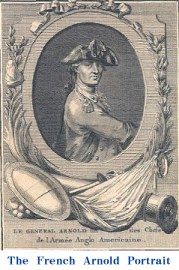
French portrait of Benedict Arnold
Another unusual portrait of Arnold was produced in France in 1778 entitled "Le General
Arnold un des Chefs de l'Armee Anglo Americaine". A modern dealer in antique prints describes it as a "lovely and strong print with baroque French embellishments"[31]. The print shows the figure of Arnold looking over his shoulder toward the viewer and dressed in French style military uniform.
The only portrait of Arnold extant in 1778 was the Hart engraving which by that time had reached France. However, the figure in the French print bears no resemblance to the one in the Hart engraving. This print is obviously another imaginary portrait of Arnold. Its value lies in its French baroque approach and not in the authenticity of its representation of Arnold. I have found this print in two of the Arnold biographies, probably because of its uniqueness as a print.[32]
Flexner Portrait
The final portrait being examined is found in the revised edition of the James Thomas Flexner biography of Arnold published in 1975[33]. The portrait appears as the frontispiece of the book. It is interesting to note that the frontispiece of the first edition of that biography used the Du Simitiere portrait of Arnold.[34] The revised edition describes the portrait as follows: "Benedict Arnold as a British general. This practically unknown miniature by an unidentified hand, which has come down from the Arnold family, is the only actual life portrait of the traitor. Courtesy, Mrs. Sophia E. Hammond."[35]
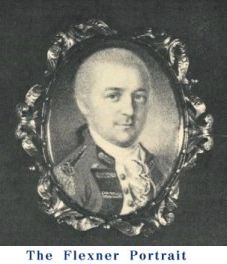
Flexner Portrait of Benedict Arnold
The description is interesting for two important reasons. First is its assertion that it has come down from the Arnold family. As in the case of the miniature in the Taylor book, if this is a family heirloom, it is probably authentic. No one would want to challenge a family heirloom on its face without good reason. In this case we are not given any information as to who Sophia Hammond is and, more important, what is her relationship to Benedict Arnold. Therefore, we are left to judge this assertion with no information.
Second, is the statement, presumably by either Flexner or the editors, that it is the only portrait of Arnold from life. The assumption in this statement is that no other Arnold portrait including the Du Simitiere portrait has been taken from life, although the authenticity of the Du Simitiere is a fact generally accepted by most authorities. It is also possible that the statement represents the position of Mrs. Hammond, whoever she may be, as to the relative reliability of the Du Simitiere portrait.
With so many questions left unanswered, it is not possible to fairly evaluate this portrait in terms of its authenticity. Until more information is known, it will be one more historical question left unanswered. If this portrait is authentic, the Du Simitiere is a fraud of immense proportion that has deceived almost all of the experts in Revolutionary War era prints. The likelihood of this portrait in Flexner's book reversing all of the conventional wisdom isvery remote.
Conclusion
Based on the best information available today, we can reasonably conclude that the Du Simitiere is the only authentic Arnold portrait that has withstood serious scrutiny by the experts in historical prints and portraits. Therefore, those historians or Arnold biographers and fiction writers who want to accurately portray Benedict Arnold should look only to the Du Simitiere portrait.
